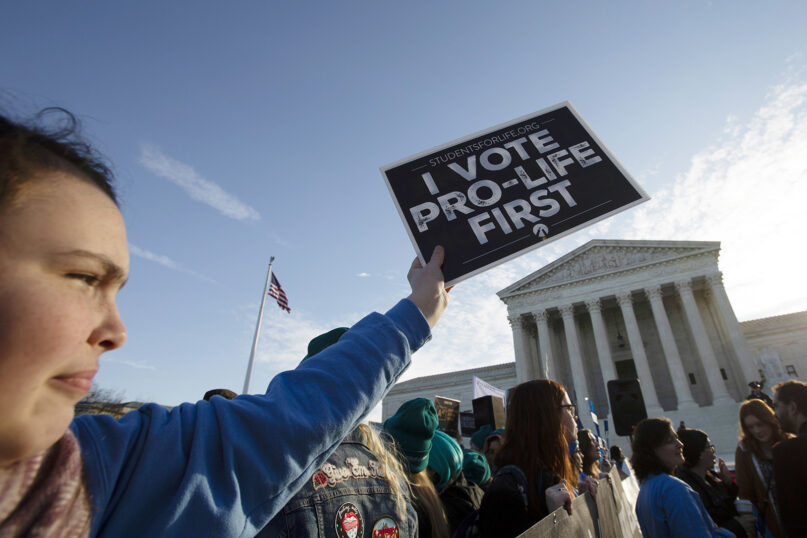(RNS) — Even months before the news broke that the U.S. Supreme Court had, in an initial round of voting, decided to overturn Roe v. Wade, I began receiving many invitations from pro-life groups to join conversations about how best to help mothers and families. With the end of Roe in sight, the robust, all-hands-on-deck push from the pro-life movement is heartening.
In my previous column I noted the wonderful programs designed to accommodate mothers’ needs by the U.S. Conference of Catholic Bishops, the Ethics and Public Policy Center and Notre Dame’s de Nicola Center for Ethics and Culture.
Some of the most impressive programming is coming from local Catholic bishops’ conferences: California’s “We Were Born Ready,” Maryland’s “Helping Hope Bloom” and Washington state’s “PREPARES” are already underway. Catholic conferences in New York, New Jersey and many others are in various states of development of their own local plans.
RELATED: Dissent from Traditional Plan dominates United Methodists’ top court meeting
One might ask where all of this support for mothers who felt they couldn’t keep their children was before it looked like Roe (and its companion SCOTUS decision, Casey) were about to fall. It’s a fair question. We should by no means discount the hundreds of millions of dollars pro-life advocates have put into pregnancy help centers and other activism in support of women and families over the years, but a focus on public policy, it must be said, has been lacking.
One significant challenge, of course, was that over the last two decades it was nearly impossible to be pro-life and also be a Democrat. If a politician was in favor of stepping up family-friendly policies, they were likely to also be signed onto the Democratic Party and its position on abortion. For the last six years, that has meant supporting abortion on request as a social good through all nine months of pregnancy paid for with pro-life tax dollars.
The only other party that could meaningfully oppose this wild extremism has traditionally been skeptical of “tax and spend” big government programs. This was due in part to some genuine disagreements about the effects of such programs, but it was also because corporations fed the GOP resources with the understanding that their taxes and regulations would be kept low.
But now we know that the Democratic Party is favored by corporations, not least because of the rise of woke capitalism. This strange turn of events, plus a populist turn in the Republican Party, has created more ideological room for creative thinking in the GOP about family-friendly policies.
From paid family leave to child allowances to adoption tax credits, pro-life U.S. senators such as Marco Rubio, Tim Scott and Mitt Romney are pushing a party once solidly against government “picking winners and losers” to rethink its assumptions.
But much old-school skepticism of government remains. Some wonder whether the programs being discussed will actually lead to fewer abortions. If there is no actual evidence, getting support for such programs from pro-life conservatives will be a challenge.
In a piece for the Institute for Family Studies titled “Is More Welfare the Solution to Abortion?”, Robert VerBruggen offers data that, though limited, provides reason to be skeptical. Comparing U.S. states’ abortion rates with their welfare generosity, he found that the states with more social support — which he calculated by adding direct cash assistance and payments to health care providers through programs like Medicaid — for the most part, had higher abortion rates than those with less social support.
VerBruggen cautions that his is “an introductory look” at the data and that “we shouldn’t draw too many conclusions from it.” One thing that could be driving down abortion rates in red states is pro-life sentiment, he writes, adding, “We can’t rule out that red states would be even more successful if they boosted welfare spending.”
There are important counterexamples that suggest the situation is more complex. States such as Georgia, Connecticut, Florida and North Carolina are near the bottom when it comes to public welfare expenditures — but near the top on abortion rates.
Furthermore, abortion rates (per 1,000 women 15-49) in pro-choice states such as New York (20.3) and Illinois (18.6) are higher than those of European countries such as Germany (5.9) and the Netherlands (8.9). The populations of these countries generally share American blue states’ views when it comes to abortion’s legality, while enjoying much stronger social support from government. Yet their abortion rates are significantly lower.
The correlation between social support and abortion rates in the U.S. over time is also quite suggestive. In 1984 the abortion rate was about 25 per 1,000 women of pregnancy age but has plummeted to around 11 today.
There is tremendous debate about why this has happened. Have massive increases in abortion restrictions played a role? Almost certainly. What about contraception? Probably, especially given increased rates at which high-dose hormone devices are being put inside women’s bodies.
But a significant part of the story is the dramatically increased social support since the 1980s. To name just a few: the Family and Medical Leave Act, the Newborns’ and Mothers’ Health Protection Act, the State Child Health Insurance Program, the Healthy, Hunger-Free Kids Act, and of course the Affordable Care Act (which included provisions of the Pregnant Women Support Act).
One last point: As I wrote in my book “Resisting Throwaway Culture,” U.S. women are having fewer children (1.8) than they say they would like (2.7). The primary reasons given for this are that childcare is too expensive (64%), they are worried about the economy (49%), can’t afford more children (44%), there’s not enough paid family leave (39%) or no paid family leave (38%).
RELATED: Dissent from Traditional Plan dominates United Methodists’ top court meeting
The choice to have, on average, one less child than they want is no doubt facilitated in part by contraception — but also by abortion as a back-up to contraception.
More study needs to be done, including in-depth interviews that get into the weeds of the complex interlocking factors. But there is plenty of evidence to suggest that increased social support will result in fewer abortions.
Of course, there are good reasons to push for many of these policies quite apart from abortion. Catholic Social Teaching insists that there are matters of justice at play here for women and families in a much broader sense.
But if the goal is to find common ground with conservative pro-life advocates who have been hesitant to support these policies in the past, but currently have a more open mind, we can make a very strong evidence-based case.






